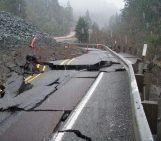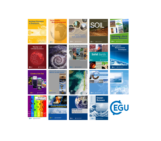
Each month we feature specific Divisions of EGU and during the monthly GeoRoundup we will be putting the journals that publish science from those Divisions at the top of the Highlights roundup. For August, the Divisions we are featuring are: Biogeosciences (BG) and Soil System Sciences (SSS). They are served by the journals: Biogeosciences (BG), SOIL, Advances in Geosciences (ADGEO), Earth Surface Dynamics (ESurf), Geoscientific Instrumentation, Methods and Data Systems (GI), Hydrology and Earth System Sciences (HESS), Natural Hazards and Earth System Sciences (NHESS), Nonlinear Processes in Geophysics (NPG) and Solid Earth (SE).
Featured highlights
 The recent state and variability of the carbonate system of the CanadianArctic Archipelago and adjacent basins in the context of ocean acidification – 11 August 2020
The recent state and variability of the carbonate system of the CanadianArctic Archipelago and adjacent basins in the context of ocean acidification – 11 August 2020
Ocean acidification is the process by which the oceans are changing due to carbon dioxide emissions from human activities. Studying this process in the Arctic Ocean is essential as this ocean and its ecosystems are more vulnerable to the effects of acidification. Water chemistry measurements made in recent years show that waters in and around the Canadian Arctic Archipelago are considerably affected by this process and show dynamic conditions that might have an impact on local marine organisms.
Rainfall intensification increases the contribution of rewetting pulses tosoil heterotrophic respiration – 25 August 2020
Carbon dioxide is produced by soil microbes through respiration, which is particularly fast when soils are moistened by rain. Will respiration increase with future more intense rains and longer dry spells? With a mathematical model, we show that wetter conditions increase respiration. In contrast, if rainfall totals stay the same, but rain comes all at once after long dry spells, the average respiration will not change, but the contribution of the respiration bursts after rain will increase.
Geoscientific Instrumentation, Methods and Data Systems:
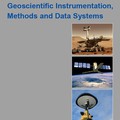 A monitoring system for spatiotemporal electrical self-potential measurements in cryospheric environments – 20 August 2020
A monitoring system for spatiotemporal electrical self-potential measurements in cryospheric environments – 20 August 2020
In times of global warming, permafrost is starting to degrade at alarming rates, requiring new and improved characterization approaches. We describe the design and test installation, as well as detailed data quality assessment, of a monitoring system used to capture natural electrical potentials in the subsurface. These self-potential signals are of great interest for the noninvasive investigation of water flow in the non-frozen or partially frozen subsurface.
Hydrology and Earth System Sciences:
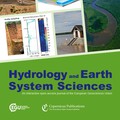 Survival of the Qaidam mega-lake system under mid-Pliocene climates and itsrestoration under future climates – 11 August 2020
Survival of the Qaidam mega-lake system under mid-Pliocene climates and itsrestoration under future climates – 11 August 2020
During the Pliocene, the Qaidam Basin on the Tibetan Plateau contained a mega-lake system. During the Pleistocene, it disappeared almost completely. Today, hyperarid climates prevail in the low-altitude parts of the basin. This study reveals that today’s mean water balance of the Qaidam Basin is nearly zero and is positive during warmer, less dry years. The results explain how the mega-lake system could survive for a long time in the past and could eventually be restored in the future.
Revisiting the global hydrological cycle: is it intensifying? – 20 August 2020
We overview and retrieve a great amount of global hydroclimatic data sets. We improve the quantification of the global hydrological cycle, its variability and its uncertainties through the surge of newly available data sets. We test (but do not confirm) established climatological hypotheses, according to which the hydrological cycle should be intensifying due to global warming. We outline a stochastic view of hydroclimate, which provides a reliable means of dealing with its variability.
Natural Hazards and Earth System Sciences:
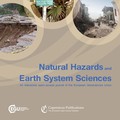 Invited perspectives: The volcanoes of Naples: how can the highest volcanic risk in the world be effectively mitigated? – 4 August 2020
Invited perspectives: The volcanoes of Naples: how can the highest volcanic risk in the world be effectively mitigated? – 4 August 2020
This paper starts by showing the present low performance of eruption forecasting and then addresses the problem of effectively mitigating the highest volcanic risk in the world, represented by the Naples area (southern Italy). The problem is considered in a highly multidisciplinary way, taking into account the main economic, sociological and urban planning issues. Our study gives precise guidelines to assessing and managing volcanic risk in any densely urbanised area.
Anthropogenic climate change and glacier lake outburst flood risk: local and global drivers and responsibilities for the case of lake Palcacocha, Peru – 27 August 2020
There is increasing interest and need to analyze the contribution of anthropogenic climate change to negative impacts of climate change. We study the case of glacial lake Palcacocha in Peru, which poses a significant flood risk to the city of Huaraz. We found that greenhouse gas emissions; strong urbanization processes without appropriate land use planning; and social, cultural, political, and institutional factors all contribute to the existing flood risk.
Other highlights
Atmospheric Chemistry and Physics:
Reviewing global estimates of surface reactive nitrogen concentration anddeposition using satellite retrievals – 4 August 2020
Multidecadal trend analysis of in situ aerosol radiative properties around the world – 6 August 2020
Remote sensing of methane leakage from natural gas and petroleum systems revisited – 13 August 2020
Molecular understanding of new-particle formation from α-pinene between-50 and +25 ∘C – 18 August 2020
An overview of and issues with sky radiometer technology and SKYNET – 25 August 2020
Impact of environmental changes and land management practices on wheatproduction in India – 6 August 2020
Incremental improvements of 2030 targets insufficient to achieve the Paris Agreement goals – 13 August 2020
Relating climate sensitivity indices to projection uncertainty – 18 August 2020
Geoscientific Model Development:
The shared socio-economic pathway (SSP) greenhouse gas concentrations and their extensions to 2500 – 27 August 2020
EGU Science in the News
A snapshot of recent English-speaking news coverage based on research published in EGU’s 19 open access journals:
- Two articles were published about a recently awarded EGU Public Engagement Grant: South Africa: Translating the Geological Record Into isiXhosa and UCT project aims to have SA’s geological record translated in local languages
- EGU’s Angela Croome Award and its first recipient, science journalist Elizabeth Gibney, were both mentioned in a Nature Briefing
- The Surprising Advantages of Virtual Conferences reported on the increased attendance at EGU2020: Sharing Geoscience Online in Scientific American
- SDSC’s ‘Comet’ Supercomputer Used to Simulate Environmental Changes in Chesapeake Bay, based on a BG study by St-Laurent et al.
- More than 75 articles about a CP study by Reichgelt et al. have been published, including ‘Mummified’ plants give glimpse of Earth’s future and Leaves long left alone have story to tell

